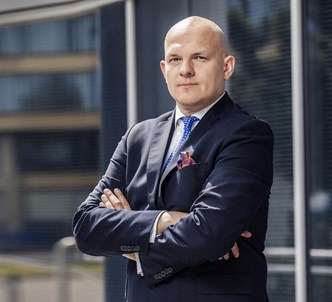Many retailers and food companies have committed to a 30-45% reduction in their scope 3 or supply chain emissions over the next 10 to 20 years as they seek to achieve net zero. With feed accounting for 50-70% of the carbon footprint of pig meat and about 70% of the footprint of poultry meat, it is a clear target for action. This is the reason Elanco has set out to demonstrate how its feed enzyme Hemicell could provide an important role in helping producers reach the targets they are set.
In today’s Industry Perspectives, Piotr Bonislawski, Elanco’s Senior Director for Public Policy - Europe & Russia, explains why the business has funded this work with international agri-food sustainability specialist Blonk Consultants.
Also in the discussion, his colleague Bruno Dias, Global Poultry Intestinal Integrity Senior Director, and George Tice, Independent Scientific, Policy and Regulatory Advisor, discuss the potential carbon footprint reduction. “Efforts to decrease this footprint will be both demanded and incentivised throughout the supply chain,” says Mr Bonislawski.
Mr Dias adds: “Hemicell is our first feed additive with a fully approved Life Cycle Assessment, underlining our steadfast commitment to sustainability.”
Besides the focus on improving sustainability, Hemicell’s key producer benefits are there, says Mr Tice. “By reducing the energy matrix, Hemicell inclusion will reduce feed costs, while delivering the health benefits associated with the reduction in feed-induced immune response.”
[Feedinfo] Many people will be familiar with the cost and performance benefits of the feed enzyme Hemicell and its impact on the Feed-Induced Immune Response (FIIR) prompted by β-mannans. As part of some specific new research, you initiated a study on Hemicell with the international agri-food sustainability specialist Blonk Consultants. What did you want to achieve - what did you want to focus on specifically and why?
|
[Piotr Bonislawski] In today's world, the sustainability of our food system is under close scrutiny due to its significant contribution to greenhouse gas emissions (GHGs). From production to distribution, the global food system accounts for about 26% of GHG emissions, with livestock and fisheries alone responsible for 31% of these emissions. Companies are increasingly exploring ways to raise awareness and reduce emissions throughout their supply chains. However, a significant challenge lies in addressing scope 3 emissions, which include indirect emissions from various sources beyond a company's direct control. |
Piotr Bonislawski |
Recognising the potential for Hemicell to reduce the carbon footprint of feed, we decided to collaborate with Blonk Consultants on calculating the extent of Hemicell’s impact. Our aim is to help our customers mitigate their carbon footprint by optimising their feed practices. Through this partnership, we seek to provide practical solutions that contribute to a more sustainable food system.
[Feedinfo] Are producers who use Hemicell likely to see any performance benefits?
|
Bruno Dias |
[Bruno Dias] Hemicell provides significant value to producers in a variety of ways. As a feed additive with a Life Cycle Assessment (LCA) that is aligned to the required guidelines, it underlines our steadfast commitment to sustainability. Hemicell specifically targets β-Mannans, a type of highly anti-nutritive fibre found in numerous feed ingredients in pig and poultry diets. These fibres trigger an inefficient innate response, leading to intestinal inflammation and a decrease in production efficiency. |
However, when producers incorporate Hemicell into their feed, they witness a marked improvement in intestinal integrity and uniformity, as well as a reduction in foot burn in poultry. Moreover, the investment in Hemicell can be offset by the decrease in feeding costs, thanks to an energy matrix value of up to 90 kcal/kg. In essence, Hemicell supports animal health and also contributes to financial efficiency and sustainability in animal production.
[Feedinfo] The work on swine diets looked at multiple weight classes, and in north-east and south-west European contexts. Can you talk through the results, where any reduction in carbon footprint is from and what impact this might have?
|
[George Tice] The two pre-requisites for such a study are first that a life-cycle assessment is performed for the production of Hemicell, and secondly that it can be shown and validated that there will be no impact on final animal performance resulting from Hemicell inclusion and energy removal from the matrix and therefore the carbon footprint of pig or poultry production. An independent nutritionist assessed the published information and meta-analyses of multiple studies, concluding that in swine 55Kcal of NE could be removed following Hemicell inclusion. |
George Tice |
The methodology that was followed for this impact assessment was based on ISO 14040/44 (ISO, 2006), aligned with guidelines of the Product Environmental Footprint Category Rules for Animal Feed (published by the European Commission, 2018) and with the FAO LEAP additive guidelines (FAO, 2020). In swine diets, the modelling resulted in a carbon footprint reduction of between 1% and 4.2% depending on diet formulation and reformulation following energy removal.
[Feedinfo] You also looked at broilers, with diets for starter, grower and finisher broilers. What were the specifics involved, and what results did you see? What is the likely wider impact of these results?
[George Tice] In broilers the study followed the same process as swine, with an independent nutritionist confirming that 60MJ could be removed from the energy matrix without any impact on bird performance.
The modelling process indicated that depending on diet formulation and reformulation following Hemicell inclusion, the carbon footprint would be reduced by between 2.7% and 3.3%.
[Feedinfo] In context, are these results significant, and do they provide a solid grounding for producers to reduce their environmental impact in a consistent, manageable and financially viable way?
[George Tice] From a financial perspective the reason to use Hemicell is that through reducing the energy matrix, Hemicell inclusion will reduce feed costs, while delivering the health benefits associated with the reduction in feed-induced immune response.
A third benefit is the potential carbon footprint reduction. Feed is 50-70% of the carbon footprint of pig meat and approximately 70% of the footprint of poultry meat. Retailers and food companies vary, but in general have committed in their ESG reports to a 30-45% reduction in their scope 3 or supply chain emissions over the next 10 to 20 years as they seek to achieve net zero. Livestock producers will need to help them achieve these reductions.
To do this, livestock producers will have to adopt several incremental innovations and changes, and the use of an enzyme such as Hemicell is one of those that should be considered.
Hypothetically, based on modelling and recent studies, a 3% reduction in the carbon footprint of broiler feed would mean a 2% reduction in the footprint of broiler meat. Now, imagine a broiler company is being asked by their retail customer to achieve a 30% reduction in their emissions over the next 10 years; such an improvement on the feed front would get that broiler company 7% of the way to its target. So Hemicell inclusion, which, independent of the carbon footprint impact, provides a return on investment, is one of several interventions to be considered by meat producers as they seek to meet their carbon footprint targets.
[Feedinfo] Overall, what are the benefits for feed manufacturers or pig or poultry producers as a result of this work? In future, might there be an opportunity to sell pig or poultry meat with a lower carbon footprint to processors at a better price?
[Piotr Bonislawski] This dynamic space is rapidly evolving, making it challenging to predict future solutions. However, one certainty is the persistent drive to reduce the carbon footprint of food production. Consequently, efforts to decrease this footprint will be both demanded and incentivised throughout the supply chain.
[Feedinfo] This research is a really interesting step in the sustainability journey. Can you talk us through how you are approaching sustainability, and how you plan to support customers through the emerging pressures?
[Bruno Dias] Sustainability is a multi-dimensional topic; it requires us to consider various aspects simultaneously, including environmental, health, welfare, social and economic factors.
With a rapidly growing global population, the issue of food security is more critical than ever. It is our mission to support our customers by providing solutions that not only reduce environmental impact, but also ensure production of affordable and safe meat/eggs. A crucial part of this is ensuring the health and welfare of the animals involved.
Elanco seeks to lead the global market in intestinal integrity and food safety. Our comprehensive portfolio is testament to our commitment to these areas. Our current focus is on delivering science-based innovations that have a significant positive impact on live animals, and creating additional value for producers. This improves animal welfare and health, and also reduces the environmental footprint of our customers, generating additional value to producers.
Published in association with Elanco






